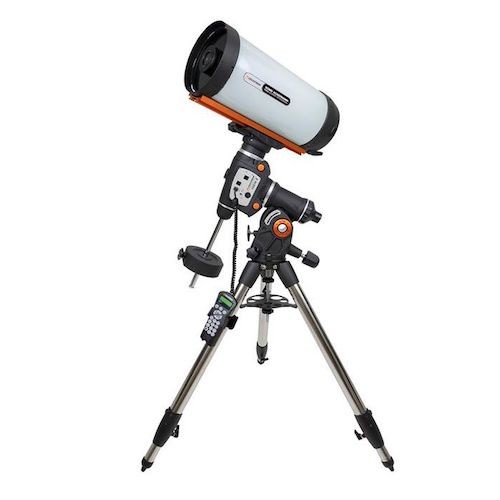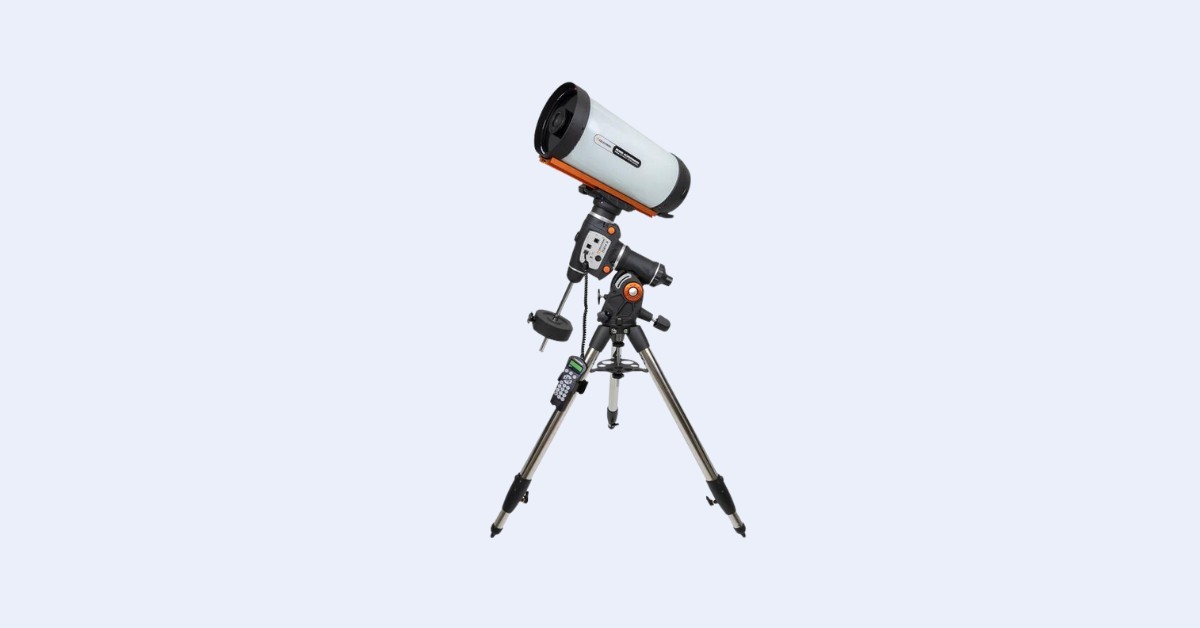The 8” RASA Optical Tube
The RASA design is a modern interpretation of the Schmidt Camera, an invention of one-handed optician Bernhard Schmidt from the 1930s. This type of sensor uses a spherical primary mirror with a very fast focal ratio to focus light directly onto a camera sensor or film. A parabolic primary mirror would be difficult to manufacture and produce too much coma to be usable, so a spherical mirror is used instead despite its aberrations that would make images fuzzy. This is solved with a mass-manufactured Schmidt corrector, a thin piece of glass with a complex curve placed at the radius of curvature of the mirror. It corrects the spherical aberration and allows for sharp images.
Celestron engineers adapted the Schmidt camera into the RASA design, which is essentially a Celestron Schmidt-Cassegrain telescope with the secondary mirror, internals, and visual back removed and replaced with a series of corrector lenses similar to a Starizona HyperStar inside the tube. Light enters the tube, is bent by the Schmidt corrector, bounces off the f/2 spherical primary mirror, and is then further corrected to produce a sharp and flat field of view by four rare earth element corrector lenses at the middle of the telescope. Cameras can be attached to the M42 or C threads at the front of the RASA’s Schmidt corrector.
As an f/2 instrument, precision and accuracy are keys in the 8” RASA. The shallow depth of field requires that the mirror and lens assembly be aligned (collimated) with great care. This is done by tilting the center assembly, to which your camera is attached. Unfortunately, this makes collimation difficult as there is no center on the primary mirror and visual inspection via an eyepiece is impossible. Also, focusing must be absolutely precise, so an electronic focuser and Bahtinov mask are recommended. For those new to astrophotography, collimating and focusing this telescope can be challenging due to its demanding tolerances.

The 8” RASA features built-in hardware inside the tube to reduce mirror flop during long exposures and vents with cooling fans at the back to acclimate the optics to ambient temperature for sharp images. A CGE-style dovetail is attached to the mount to attach the telescope, while a handle is built into the back to assist with lifting it onto a mount. Additionally, holes are drilled in the 8” RASA to allow you to attach a second CGE dovetail (not included). A dovetail at the top of the tube allows you to attach a guide scope, mini computer, or other astrophotography accessories.
Accessories
The CGEM II RASA 800 package doesn’t include any eyepieces or other visual accessories, as it is not compatible with them. Additionally, no finder scope is included since the telescope can be aimed by plate-solving. All that comes with the CGEM II RASA package is a set of camera adapters, a DC power cord, and a battery pack for the cooling fan.
The CGEM II Equatorial Mount
The Celestron CGEM II is a mid-range “EQ6 class” equatorial mount that is priced and weighed between the more affordable Advanced VX and the higher-end CGX from Celestron, with a similar theoretical capacity to the Sky-Watcher EQ6Ri Pro. The CGEM II has a stated weight capacity of 40 lbs, with around half of that being the recommendation for imaging purposes. Unfortunately, the CGEM II shares many of the same flaws as the Advanced VX, namely its cheap servo motors. Our review of the CGEM II explains further the differences between the CGEM and other high-quality stepper-driven mounts.
At 17 lbs bare and rising to above the CGEM II’s theoretical limit of 20 lbs when equipped, the 8” RASA should theoretically be too much for it to handle. Fortunately, the 8” RASA’s 400mm focal length makes it more tolerant of tracking and guiding faults, allowing one to use the CGEM II without too many problems, though autoguiding is highly recommended.
The CGEM II uses a dual dovetail saddle capable of accommodating Vixen, Losmandy, and Celestron CGE style dovetail plates. The RASA 800 attaches with the CGE-style plate, which is more rigid than a narrower Vixen bar would be, and essentially the same as a Losmandy-style dovetail. A single 17 lb counterweight is provided with the CGEM II to balance the RASA 800, with room for more if needed; most counterweights intended for smaller equatorial mounts fit the CGEM II’s ¾” shaft.
To operate the CGEM II with the 8” RASA, you’ll need to use Celestron’s CWPI software or an ASCOM driver-compatible program like NINA. After polar aligning the mount and balancing the RASA on top, you’ll just need to focus, and then the software will use your camera to plate-solve, identifying where it is in the sky until your target is centered. Most capture software also has controls for a motor focuser and autoguiding, the latter of which will require the purchase of a guide scope and a guide camera that can be connected to the CGEM II’s ST4 autoguider port. The CGEM II’s provided NexStar+ hand controller is used merely as an adapter to connect to your PC with a MicroUSB cable; you cannot connect to the CGEM II directly with a PC as with most other mounts, which prevents the use of EQMod software or autoguiding through a USB connection without the ST4 port.
Camera Limitations
Because of its design, the 8” RASA telescope is severely limited as to the types of cameras that can be used with it. DSLR cameras and large CCD cameras are not viable, as they will block too much of the aperture of the telescope and may not reach focus. Even if any obstructions can be avoided, the RASA’s spacing requirements mean that monochrome cameras are not a good fit, as a filter wheel would require too much back focus and obstruct the aperture. Cooled “one shot” astronomical color CMOS cameras are generally recommended for use with this telescope, although ordinary mirrorless cameras can also work (albeit with a greater, rectangle-shaped obstruction of the aperture). The 8” RASA has a full illuminated field of 32mm diagonal, so “full frame” 42mm sensors may suffer from some vignetting, although this can be managed through cropping.
Cables, which you will need to use to connect your camera to your computer as well as power it, can lead to optical artifacts in your images as they will pass in front of the RASA’s corrector, but they can be managed to create diffraction spikes like in a Newtonian reflector with careful arrangement.
Should I buy a Used Celestron CGEM II 800 RASA?
Given the sheer complexity of the RASA, we would only recommend buying a used one from a reputable vendor or someone you know. The CGEM is also not the best mount, and as such, we would recommend trying to just get the RASA optical tube and buying a better mount if you shop used.
Aftermarket Accessory Recommendations
The CGEM II 8” RASA requires a few pieces of additional equipment to function. Since this is an imaging telescope, you’ll have to choose plenty of accessories on the telescope side depending on your budget, goals, or any equipment you already have. However, regardless, a polar scope or automated alignment tool such as the PoleMaster is necessary since you cannot use the All-Star Polar Align function with the 8” RASA. An AC adapter or a rechargeable power supply like the Celestron PowerTank Lithium Pro is also needed to run the CGEM II mount.
To image with the 8” RASA, you’ll likely want a cooled astronomical camera in lieu of a mirrorless camera unless you happen to have one. A suitable guide scope/camera combination is necessary to autoguide the CGEM II, along with a Bahtinov mask for focusing your telescope. A dew heater or dew shield helps to protect the RASA’s front corrector and your camera from dew and the latter can assist in managing cables, Furthermore, at f/2 to simply and automate focusing a motor focuser may be desired as well, with options for the former available from Celestron, ZWO, and Pegasus.
An extra dovetail bar for the top of the 8” RASA is recommended to attach extra accessories, such as the guide scope, dew controllers (required if you purchase a dew heater), and help route cables and other power/control-related equipment. You could also attach a mini PC directly to the top of the 8” RASA with this arrangement and control it via a desktop or laptop connected over WiFi to your rig, or you’ll need to plug your computer directly into the CGEM II’s hand controller for use.
What can you see?
There is nothing to see with the 8” RASA, as it cannot accept an eyepiece.
Astrophotography Capabilities
The 8” RASA telescope is an impressive imaging tool. Its f/2 speed allows you to shoot the brightest of objects like the Orion Nebula or the Andromeda Galaxy with far less exposure time and a better signal-to-noise ratio than with a smaller telescope. The CGEM II’s acceptable – or at least superior to the Advanced VX – tracking and guiding accuracy, combined with the extremely lax requirements for tracking/guiding at 400mm focal length, means you can take very long individual exposures and shoot huge but faint targets, such as supernova remnants or integrated flux nebulae, which simply lack sufficient brightness to be imaged with smaller telescopes and cheaper sensors. However, if you want to go after smaller objects like galaxies and globular clusters, a longer focal length instrument like a Newtonian reflector, a Ritchey-Chretien, or an aplanatic Schmidt-Cassegrain telescope and reducer would probably be a better choice; the 8” RASA is just too short in focal length to deliver detail on these objects without massive undersampling problems.



